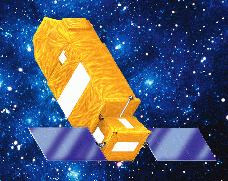

Mission Status Report #21 Star Date: October 11, 1999 NOTE: Mission Status Reports on the web page will continue roughly once a week, as events unfold. 

A graphic view of the FUSE on orbit (left) and the Satellite Control Center at JHU (right). (Click either image to see larger version.)
FUSE Science Mission Phasing InFUSE operations have picked up after the Instrument Data System code load described in the last report, and we have spent much of the last week performing observations on carefully selected science targets. While most of the science we intend to perform with FUSE relies on the careful focussing and alignment procedures that are yet to come, not all objects require these refinements. Hence, where in makes sense in the timeline and for the objects being observed, we have started performing science observations with the FUSE satellite!! The observations done so far are mostly on faint, extragalactic targets that do not require high spectral resolution and also request long integration times. Hence, these can be observed for a day or more at a time, filling in the timeline gaps between time critical checkout activities. We expect to continue in this manner, getting science observations when we can while completing the checkout of the satellite. Observing faint targets right now is also important for another reason: our ground station antenna at the University of Puerto Rico continues to be only partially functional and undependable for uplink of commands and (sometimes) downlink of data. The faint targets we have been observing only generate a moderate amount of data, which can readily get transferred to the ground through our "backup" system. (A similar ground station at NASA's Wallops Flight Facility is being used to fill in, along with commercial passes through a Hawaii station.) Hence, despite some continuing difficulties, we are making progress! It has been a big boost to morale to see some science data streaming in, and there are positive signs in these data that point to success ahead. Background rates and scattered light appear to be very low (which is good) and the sensitivity of the channels appears to be as expected from ground calibration, meaning exposure to the space environment has done nothing significant to our sensitivity. Target acquisitions continue to go very well, with only an occasional blip due to a guide star that was fainter than expected or some similar minor effect. Much of the next week will be spent performing detailed tests that should permit the focussing and channel alignment to proceed. (Alignment was last discussed in the report from September 24, 1999.) One of these tests was run over the weekend just passed and the data are being analyzed. Two further tests are scheduled later this week, and continued science observations are also being scheduled. Reported by: Bill Blair, Chief of Mission Planning
|